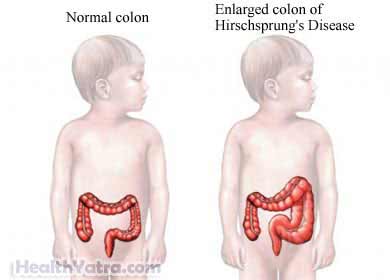Definition
Hirschsprung’s disease is a rare disorder of the colon. It is present at birth. This disease causes problems with the movement in the colon. It usually affects the last 1-2 feet of the colon. Hirschsprung’s can make it difficult to have effective bowel movements. It occurs most often by itself but can also be part of a syndrome.
Causes
The colon is a muscular tube. It pushes waste to the rectum by squeezing then relaxing. Nerves tell the colon when to squeeze and when to relax.
In Hirschsprung’s disease, the nerve cells that tell parts of the colon to relax are missing. This means that parts of the colon never relax and fully open. This can make it difficult for the waste to move through the affected area.

The missing nerve cells are due to a genetic defect. In some cases, Hirschsprung is hereditary. This means parents could pass it to their children. Genes from the parents can be passed even if the parents do not have the disease.
Risk Factors
Factors that may increase your child’s chance of Hirschsprung’s include:
- Family members with the disease
- Sex: male
- Presence of Down Syndrome
- Presence of other congenital defects
Symptoms
Symptoms can differ by age.
Symptoms found in newborn include:
- Failure to pass meconium within the first 48 hours of life (Meconium is the first bowel movement.)
- Vomiting after eating
- Swelling of abdomen
Symptoms found in young children include:
- Severe constipation
- Diarrhea
- Anemia—blood disorder
- Growth delay
Symptoms found in teenagers include:
- Severe constipation for most of their lives
- Anemia—blood disorder
Diagnosis
Hirschsprung’s disease is often diagnosed in infancy. Some may not be diagnosed until adolescence or early adulthood.
Your doctor will ask about your child’s symptoms and medical history. A physical exam will be done. Tests to confirm Hirschsprung’s may include:
- X-ray—images of colon
- Barium enema—fluid is injected into the rectum to make the colon show up on an x-ray areas in the colon
- Biopsy—a sample of bowel tissue is taken to determine if nerve cells are missing
- Anorectal manometry—measures the pressures of inside the colon with a rectal balloon
Treatment
Surgery is the primary treatment for Hirschsprung’s. It eliminates symptoms in 90% of children. The earlier the treatment is done the better the outcome may be. Recovery may also be easier if a shorter bowel segment is involved.
The goal of surgery is to remove the affected portion of the colon. Other surgery may be done to provide support to the bowel while it heals. Potential surgical procedures may include:
- Pull-through operation—The affected area of the colon is removed. The remaining healthy colon is then brought down and joined to the rectum.
- Colostomy—This may be done to allow your bowel time to rest and heal. After the affected area of colon is removed, the healthy colon is not immediately connected to the rectum. Instead, the colon is attached to an opening in the abdominal wall. Waste will then pass through this opening and into a bag outside the body. This may be done in children who are very sick or have a large portion of the colon affected.
- Closure of the colostomy—Once the area has healed, the colon will be connected to the rectum. The colostomy opening will be closed. Bowel function will gradually return to normal.
Surgery of the bowel can cause some serious complications. Talk to your doctor about treatment benefits and risks.
Prevention
There are no guidelines for the prevention of Hirschsprung’s.
If you have one child with the disease, you could have more children with the disease. Talk to your doctor about the risk. Consider going to genetic counseling.
